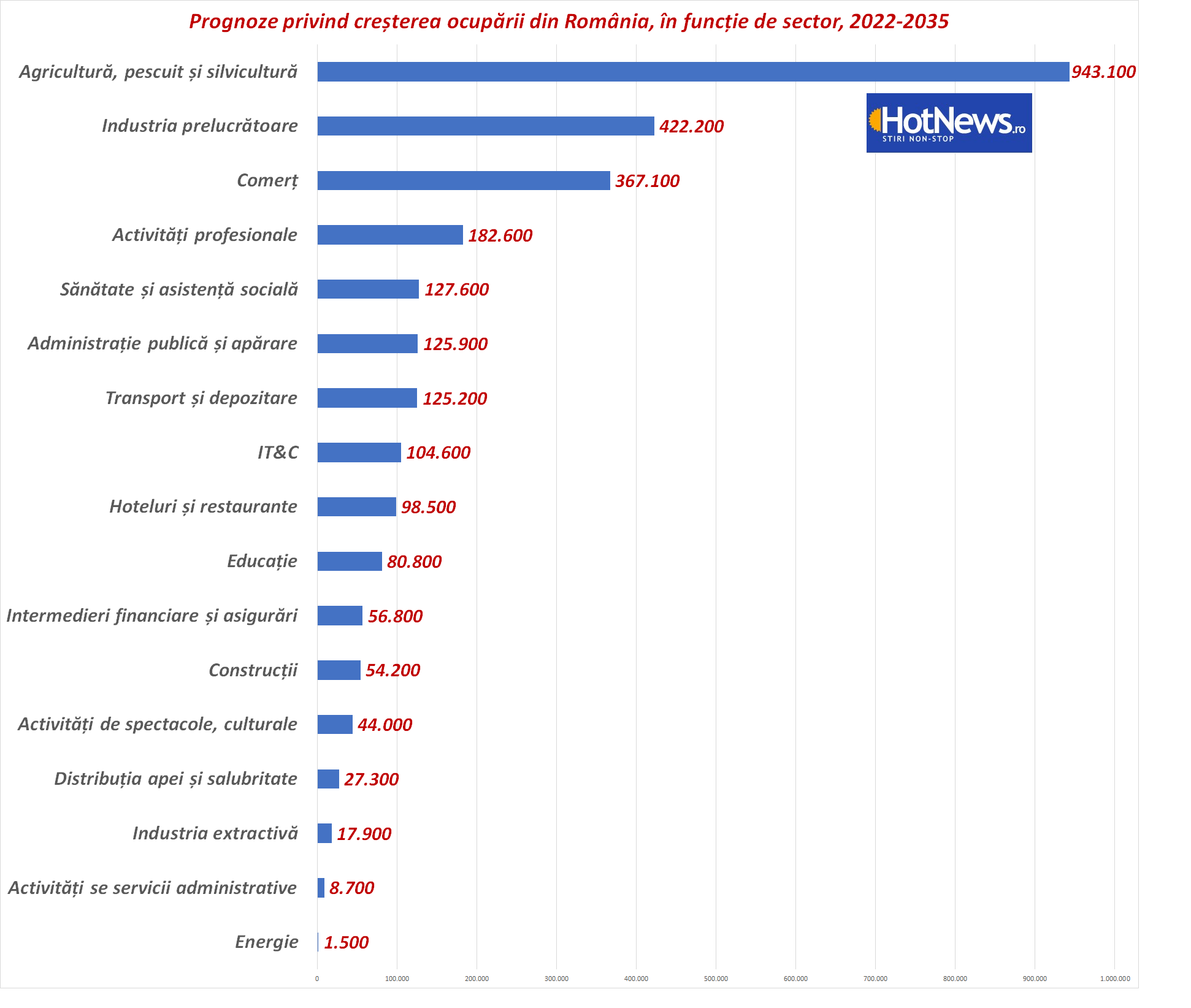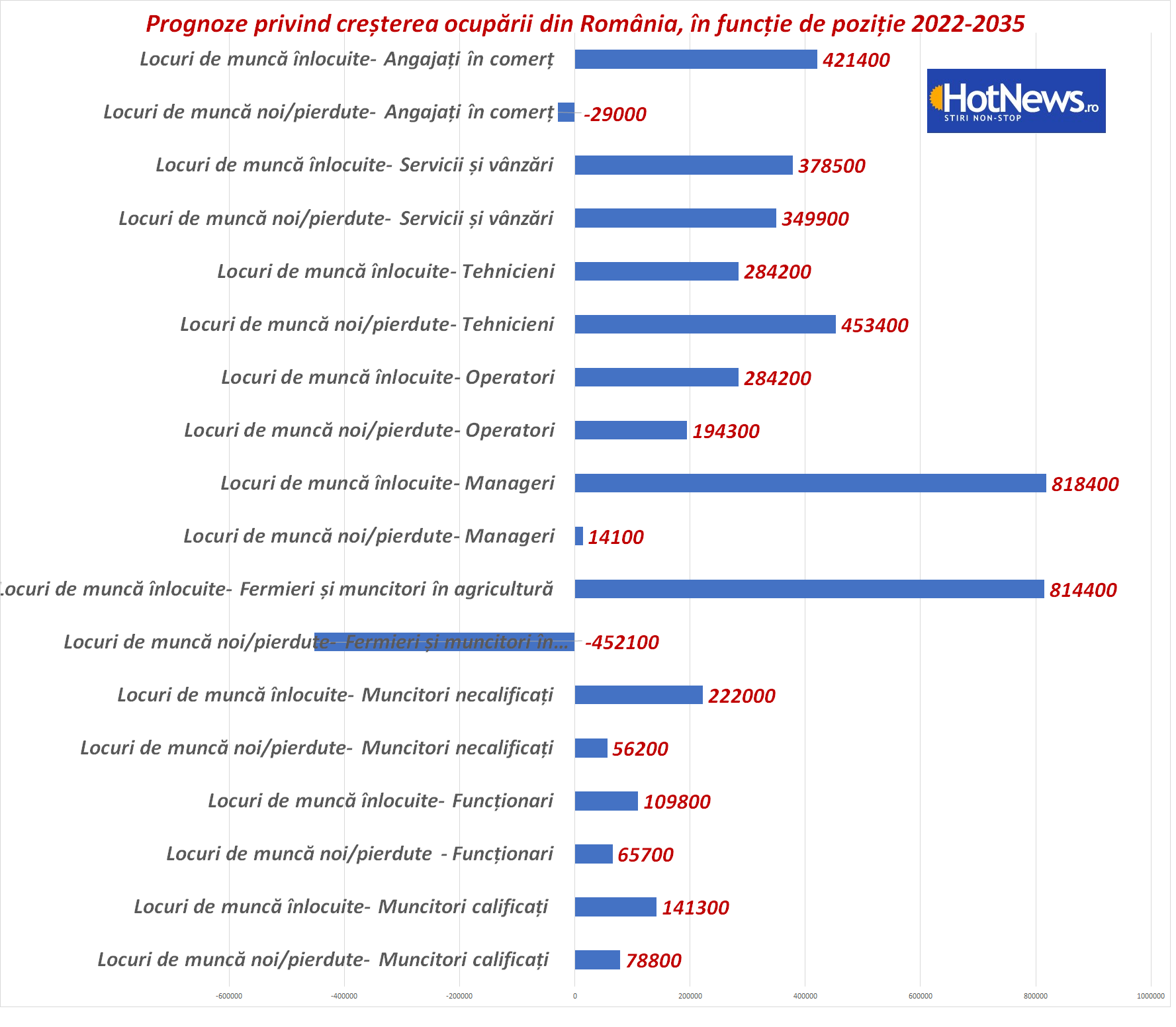
According to AmCham’s labor market analysis, agriculture, manufacturing and trade are the sectors of the economy that will have the greatest need for workers in the next 10 years.
The National Strategy and Forecasting Commission (CNSP) estimates an increase in the average registered number of employees in the next 3 years by approximately 440,000 people, i.e. by an average of 146,000 people per year.
Over the past 10 years, the number of employees has grown by an average of 75,000 people annually, with higher values recorded in 2016-2019.
A quarter of jobs will be changed: some will be eliminated and others will be created
The global labor market is set to undergo significant changes in the coming years – nearly a quarter of jobs will change over the next five years, according to a new report from the World Economic Forum.
About a quarter of jobs will be changed: some will be eliminated and others will be created. The WEF expects 14 million fewer jobs in five years, as 83 million jobs will disappear and only 69 million will be created.
The transition to renewable energy systems will be a strong driver of job creation, while slowing economic growth and high inflation will lead to losses.
The report’s findings are based primarily on a survey of 803 companies employing a total of 11.3 million workers in 45 different economies around the world.
Among the sectors that could see an increase in technology-related jobs are education, agriculture and health care, the report added.
We have a problem of undeclared work
According to an analysis by AmCham, there are approximately 1.4 million people in undeclared work in Romania, which is about a quarter of the 5.1 million full-time workers.
This is a serious problem, especially in the context of Romania’s low employment rate (68.5% in 2022) compared to the EU average (75% in 2022).

Undeclared work puts pressure on state budget revenues and negatively affects labor supply. Last but not least, high levels of undeclared work limit estimates of labor supply, creating additional challenges for companies’ investment decisions.
Manufacturing, trade and health care combine about half of the workforce in Romania
Manufacturing, trade and healthcare are the sectors with the largest number of workers. In total, they make up 47% of the average number of employees in Romania
IT&C (24%), health care (15%) and professional activities (15%) are the sectors with the highest growth rates in the number of employees in the recent period.

Employers are not filling more than 45,000 vacancies in Romania, even though we hear from all channels that the country has no workforce. Qualified candidates who would fill these gaps in the labor market seem to be nowhere to be found.
The capital has the highest vacancy rate in the country. According to the National Institute of Statistics, there is a shortage of transport and storage workers, IT workers, health care or construction workers in Bucharest.
This is correct, and we may have problems with the accuracy of these numbers. Despite the fact that companies are obliged (according to Law 76/2002 as amended) to announce every vacancy that appears (otherwise they face heavy fines), this does not happen for various reasons. Many companies prefer to fill their vacancies without notifying the authorities, so the figures provided by the INS more or less correspond to the reality of the market.
“In the spring and summer, vacancies still increase because, at least in the case of tourism, we are talking about seasonal jobs. Tourism in the warm season is more stable than in the cold season, even if there is also winter tourism,” explained labor market expert Katelin Ginaru in an interview with HotNews.
What is the value of the vacancy for the company
Determining the cost to a company of a job vacancy isn’t too difficult to do, but it’s a bit more nuanced: you can’t easily quantify the impact on team morale and the timelines of projects the company is involved in. Roughly speaking, an example can be given:
Take the ABC calendar company that just lost an employee. The person received compensation of €1,000 per month and the company anticipates a 60-day waiting time to find a replacement. ABC Calendare has 100 employees and generates an annual revenue of €300,000.
First, we calculate the amount of income lost as a result of the vacancy.
We determine the average company/employee revenue (by dividing the company’s annual revenue by the total number of employees), which is €3,000 per year. Since the year consists of 250 working days in the organization, this means that the employee “makes” an average of 12 euros per day (3000/250).
If a company has to wait 60 days to fill a vacancy, that means a loss of €720. It’s just that this calculation needs to be adjusted taking into account the impact of the vacancy. If it’s a leadership position, the impact can be threefold. In middle management, the impact can also be double the standard calculation.
There is a very strong discrepancy between the logic of demand and supply in the labor market
These disparities are not the result of an imbalance in skills, but rather an imbalance in access to the labor market. Instead of thinking about whether a candidate has a college degree, in some specialties, an employer should probably ask “who can do the job today and improve the job to be as productive as possible.”
According to Eurostat, Romania is the country with the highest level of mismatch between work and the field in which workers studied. Moreover, this degree of mismatch has increased over the last 5 years, while in other states it is being reduced by public policies that address problems in education so that the real demand for labor in the economy matches the supply as closely as possible.
The skills mismatch ratio is defined as the mismatch between a person’s current occupation and the field in which they studied. In the 15-34 age group, according to some experimental statistics published by Eurostat, we are the worst in this section. People who work in a different field in terms of education are considered people with a horizontal skill mismatch.
There is also a vertical mismatch, involving those who perform work below their level of training (those with medical degrees working as simple assistants, for example), or those who work in a more skilled position than their training would allow.
“There is a mismatch, a very strong mismatch between demand and supply in the labor market. I would say between the logic of demand and the logic of supply,” Ginaru says.
“I mean what business entities demand – it’s about the logic of demand. When I say propositional logic, I mean what people have actually done. People have always gone to the idea of improving their professional training. The number of graduates of higher education in our country has greatly increased, this is one of the largest increases in Central and Eastern Europe. But the labor market did not offer such jobs that would suit these graduates,” Katalin Ginaru believes.
Almost 40% of higher education graduates in Romania are concentrated in public administration, education and health care
A Romanian researcher has shown in an article that, unfortunately, the majority of higher education graduates in Romania are currently concentrated in the public administration sectors. Almost 40% of higher education graduates in Romania are concentrated in public administration, education and health care.
Employment in construction will grow relatively strongly between 2022 and 2030, while employment in agriculture will continue to decline
According to the pan-European study, in the manufacturing sector, employment growth will be largely driven by employment growth in the food industry, beverage and tobacco manufacturing, and engineering.
Sub-sectors such as wholesale and retail trade, accommodation, catering and transport will see the number of workers increase, even if in the case of transport or logistics, job growth will be strongly affected by robotics and automation.
In the services sector, activities such as legal, accounting, consulting and telecommunications services will have the strongest results, while administrative services will be the weakest.
Companies hiring for positions traditionally classified as middle-skilled jobs (defined by economists as requiring a high school diploma but not a bachelor’s degree, such as accounting or secretarial) today often say they require applicants to have a degree bachelor’s degree
Check out the full AmCham review here
Source: Hot News
Lori Barajas is an accomplished journalist, known for her insightful and thought-provoking writing on economy. She currently works as a writer at 247 news reel. With a passion for understanding the economy, Lori’s writing delves deep into the financial issues that matter most, providing readers with a unique perspective on current events.